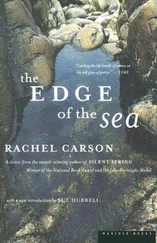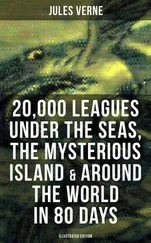The most startling theory (and the one that seems to have the fewest supporters) is that the layer consists of concentrations of squid, ‘hovering below the illuminated zone of the sea and waiting the arrival of darkness in which to resume their raids into the plankton-rich surface waters.’ Proponents of this theory argue that squid are abundant enough, and of wide enough distribution, to give the echoes that have been picked up almost everywhere from the equator to the two poles. Squid are known to be the sole food of the sperm whale, found in the open oceans in all temperate and tropical waters. They also form the exclusive diet of the bottle-nosed whale and are eaten extensively by most other toothed whales, by seals, and by many sea birds. All these facts argue that they must be prodigiously abundant.
It is true that men who have worked close to the sea surface at night have received vivid impressions of the abundance and activity of squids in the surface waters in darkness. Long ago Johan Hjort wrote:
One night we were hauling long lines on the Faroe slope, working with an electric lamp hanging over the side in order to see the line, when like lightning flashes one squid after another shot towards the light… In October 1902 we were one night steaming outside the slopes of the coast banks of Norway, and for many miles we could see the squids moving in the surface waters like luminous bubbles, resembling large milky white electric lamps being constantly lit and extinguished. [7] Even today the mystery of the scattering layer has not been completely revolved. Through an ingenious combination of new techniques, however, the picture is gradually becoming clearer. It now appears that at least in some areas—as over the continental shelf off New England—fishes may compose a substantial part of the layer. This has been determined by studying it with a sound source that embraces many frequencies (the ordinary echo sounder is a single-frequency device). This method not only reveals the vertical migration but brings out the fact that the very nature of the scattering changes with depth. Such changes are best interpreted as originating in the swim bladders of fishes, which are compressed under the increasing pressure of a descent into deeper levels of the sea but which expand with ascent toward the surface and consequent lessening of pressure. The formerly held objection that fishes could not possibly be abundant enough to account for the very widespread occurrence of the scattering layer has melted away in the light of information new techniques have given us. It was formerly supposed that a strong echo implied a very dense concentration of whatever creatures were returning the echo. Now it is realized that the tracings recorded by the echo sounder do not necessarily indicate the density of the animals in the scattering layer, so that actually a dark tracing on the record may be produced by only a few strong scatterers passing through the beam in any particular instant of time. One of the study methods increasingly used during the 1950’s was an underwater camera correlated with an echo sounder. All pictures of fishes so obtained have been accompanied by strong echoes. None of these findings rule out the possibility that other organisms may also help to compose the scattering layer. They do furnish rather convincing evidence that fishes compose an important part of a phenomenon that, in all probability, lends itself to no single explanation, but varies as to the species composing it over the vast areas of the ocean.
Thor Heyerdahl reports that at night his raft was literally bombarded by squids; and Richard Fleming says that in his oceanographic work off the coast of Panama it was common to see immense schools of squid gathering at the surface at night and leaping upward toward the lights that were used by the men to operate their instruments. But equally spectacular surface displays of shrimp have been seen, and most people find it difficult to believe in the ocean-wide abundance of squid.
Deep-water photography holds much promise for the solution of the mystery of the phantom bottom. There are technical difficulties, such as the problem of holding a camera still as it swings at the end of a long cable, twisting and turning, suspended from a ship which itself moves with the sea. Some of the pictures so taken look as though the photographer has pointed his camera at a starry sky and swung it in an arc as he exposed the film. Yet the Norwegian biologist Gunnar Rollefson had an encouraging experience in correlating photography with echograms. On the research ship Johan Hjort off the Lofoten Islands, he persistently got reflection of sound from schools of fish in 20 to 30 fathoms. A specially constructed camera was lowered to the depth indicated by the echogram. When developed, the film showed moving shapes of fish at a distance, and a large clearly recognizable cod appeared in the beam of light and hovered in front of the lens.
Direct sampling of the layer is the logical means of discovering its identity, but the problem is to develop large nets that can be operated rapidly enough to capture swift-moving animals. Scientists at Woods Hole, Massachusetts, have towed ordinary plankton nets in the layer and have found that euphausiid shrimps, glassworms, and other deep-water plankton are concentrated there; but there is still a possibility that the layer itself may actually be made up of larger forms feeding on the shrimps—too large or swift to be taken in the presently used nets. New nets may give the answer. Television is another possibility. [8] In 1957 Bruce C. Heezen of the Lamont Geological Observatory published a fascinating compilation of fourteen instances of whales entangled in submarine cables between 1877 and 1955. Ten of these accidents occurred off the Pacific coast of Central and South America, two in the South Atlantic, one in the North Atlantic, and one in the Persian Gulf. All entanglements involved sperm whales and it is possible the concentration of reports off the coasts of Ecuador and Peru may be related to a seasonal migration of these whales. The greatest depth at which a whale was found entangled was 620 fathoms or nearly two-thirds of a mile. More whales were trapped by cables at about 500 fathoms than at any other depth, suggesting that the natural food of the sperm whale may be concentrated at about this level. Two significant details were observed in most of these cases: the entanglement occurred near the site of earlier repairs where slack cable lay on the bottom, and the cable was usually wrapped around the whale’s jaw. Heezen suggests that as a whale skims along the ocean bottom in search of food its lower jaw may become entangled in a slack loop of cable lying on the bottom. The struggles of the whale to free itself could easily result in its complete entanglement in the cable.
Shadowy and indefinite though they be, these recent indications of an abundant life at mid-depths agree with the reports of the only observers who have actually visited comparable depths and brought back eyewitness accounts of what they saw. William Beebe’s impressions from the bathysphere were of a life far more abundant and varied than he had been prepared to find, although, over a period of six years, he had made many hundreds of net-hauls in the same area. More than a quarter of a mile down, he reported aggregations of living things ‘as thick as I have ever seen them.’ At half a mile—the deepest descent of the bathysphere— Dr. Beebe recalled that ‘there was no instant when a mist of plankton… was not swirling in the path of the beam.’
The existence of an abundant deep-sea fauna was discovered, probably millions of years ago, by certain whales and also, it now appears, by seals. The ancestors of all whales, we know by fossil remains, were land mammals. They must have been predatory beasts, if we are to judge by their powerful jaws and teeth. Perhaps in their foragings about the deltas of great rivers or around the edges of shallow seas, they discovered the abundance of fish and other marine life and over the centuries formed the habit of following them farther and farther into the sea. Little by little their bodies took on a form more suitable for aquatic life; their hind limbs were reduced to rudiments, which may be discovered in a modern whale by dissection, and the forelimbs were modified into organs for steering and balancing.
Читать дальше












